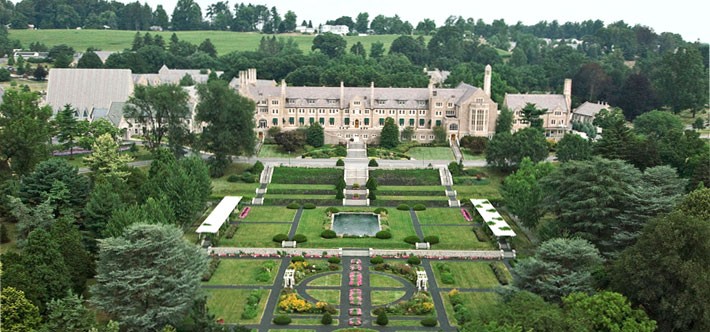Historic Masonic Villiage at Elizabethtown
Introduction
Text-to-speech Audio
Images
An overhead view the main buildings of the Etown Masonic Village campus

Backstory and Context
Text-to-speech Audio
On September 3, 1810, Captain John Wolfley organized the first Masonic lodge in Elizabethtown; Amictia #116. In 1814 the Elizabethtown and Marietta masonic lodges merged and, in 1837, dissolved when the Anti-Masonic Party controlled Pennsylvania political establishment. On September 15, 1915, the Grand Lodge of Pennsylvania constituted Elizabethtown Lodge #682. In 1926, the lodge was named in honor of Dr. Abraham C. Treichler, local attending physician of the Masonic Village.
In 1903 at a meeting of the Grand Lodge of Pennsylvania in Philadelphia, David A. Sawdey, Perry-Keystone Lodge #392, Erie proposed the idea of locating “homes for the care of our indigent Brethren, their aged wives, widows, and orphan children” at one convenient place in a country setting. In December 1908, the Grand Lodge approved a proposal for the creation of a Masonic Home with the requirements it be centrally located within the state and readily accessible on the main line of a railroad. The Grand Lodge appointed a committee of eleven with authority to “purchase real estate, employ architects, and erect the necessary buildings for a Masonic Home.” The site chosen for the Masonic Village was a series of farms in Elizabethtown on Conoy Creek with eighteen springs. On April 1, 1910, the Grand Lodge of Pennsylvania took title of 957 acres in Elizabethtown for $134,296.54.
The Grand Lodge Hall was designed by architect Clarence C. Zantzinger from Lodge #610 Philadelphia in conjunction with expert Warren P. Laird, Professor of Architecture from the University of Pennsylvania. The contractor was John R. Wiggins of Philadelphia and was constructed out of Holmesburg granite, Indiana Limestone, and Wyoming bluestone. The Grand Lodge Hall was dedicated on June 5, 1913. Between 25,000 and 30,000 people attended the dedication. Two years earlier, more than 8,000 people attended the cornerstone laying ceremonies at noon on September 26, 1911. The date was already significant as it marked the 125th anniversary of the Grand Lodge of Pennsylvania’s independence form the Grand Lodge of England. In 1910, the editors of American Architect noted the Masonic Village has the “character of a place of comfort and protection for the members of a family” with aspects of “dignity and hospitality.” Formal gardens, six and a half acres in front of Grand Lodge Hall, were built from 1930 through 1932 by Gustaf E. Malmborg.
